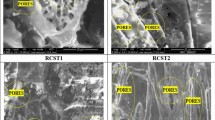Abstract
Two different treatments are given to coconut shell (CS) aggregate to enhance its quality. Slaked lime (SL) and sago flour (SF) are the two materials used and treated in CS. In this study, ten discrete types of treatment have been followed in CS using SL and SF. Pores presented in CS and water-absorbing capacity were substantially reduced by treating CS. The rate of pores present in CS was calculated using ImageJ software through scanning electron microscopic (SEM) images, in two ways, viz. 8 bits and RGB. ImageJ software (extract) supports the results obtained on the treated CS aggregates. It is concluded that the CS aggregates treated reduces pores present in it and hence reduces its water-absorbing capacity.
Access this chapter
Tax calculation will be finalised at checkout
Purchases are for personal use only
Similar content being viewed by others
References
Gunasekaran K, Kumar PS, Lakshmipathy M (2010) Compatibility studies on the coconut shell cements composites. Indian J Indian Concrete Inst 11(1):27–31
Gunasekaran K, Kumar PS, Lakshmipathy M (2011) Study on properties of coconut shell as an aggregate for concrete. Indian J Indian Concrete Inst 12(2):27–33
Gunasekaran K, Kumar PS, Lakshmipathy M (2011) Mechanical and bond properties of coconut shell concrete. Constr Build Mater 25(1):92–98
Gunasekaran K, Annadurai R, Kumar PS (2013) Study on reinforced lightweight coconut shell concrete beam behavior under flexure. Mater Design 46:157–167
Gunasekaran K, Annadurai R, Kumar PS (2013) Plastic shrinkage and deflection characteristics of coconut shell concrete slab. Constr Build Mater 43:203–207
Gunasekaran K, Ramasubramani R, Annadurai R, Prakash Chandar S (2014) Study on reinforced lightweight coconut shell concrete beam behavior under torsion. Mater Design 57:374–382
Gunasekaran K, Annadurai R, Kumar PS (2015) A study on some durability properties of coconut shell aggregate concrete. Mater Struct 48:1253–1264
https://www.google.com/search?q=coconut+shell+products&oq=coconut+shell+&aqs=chrome.4.69i57j0l7.6698j0j8&sourceid=chrome&ie=UTF-8. Retrieved on 01.07.2020 at 09.00 am
Mannan MA, Alexander J, Ganapathy C, Teo DCL (2006) Quality improvement of oil palm shell (OPS) as coarse aggregate in lightweight concrete. Build Environ 41:1239–1242
Traore YB, Messan A, Hannawi K, Gerard J, Prince W, Tsobnang F (2018) Effect of oil palm shell treatment on the physical and mechanical properties of lightweight concrete. Constr Build Mater 161:452–460
Maryono, Sudding and Rahmawati (2013) Preparation and quality analysis of coconut shell charcoal briquette observed by starch concentration. J Chemica 14:74–83
Sudding and Jamaluddin (2016) The processing of produce Reneweable energy sources. ICMSTEA 2016: international conference on mathematics, science, technology, education and their applications, Makassar, Indonesia, 3–4 October 2016
Acknowledgements
The authors desire to acknowledge SRM Institute of Science and Technology’s Management for their sustenance to complete this research. Also, thanks to those who directly or indirectly assisted in this research study.
Author information
Authors and Affiliations
Corresponding author
Editor information
Editors and Affiliations
Rights and permissions
Copyright information
© 2022 The Author(s), under exclusive license to Springer Nature Singapore Pte Ltd.
About this paper
Cite this paper
Thilagashanthi, T., Gunasekaran, K., Satyanarayanan, K.S. (2022). Reduction of Pores and Water Absorption of Coconut Shell Aggregate on Treatments. In: Satyanarayanan, K.S., Seo, HJ., Gopalakrishnan, N. (eds) Sustainable Construction Materials. Lecture Notes in Civil Engineering, vol 194. Springer, Singapore. https://doi.org/10.1007/978-981-16-6403-8_31
Download citation
DOI: https://doi.org/10.1007/978-981-16-6403-8_31
Published:
Publisher Name: Springer, Singapore
Print ISBN: 978-981-16-6402-1
Online ISBN: 978-981-16-6403-8
eBook Packages: EngineeringEngineering (R0)




